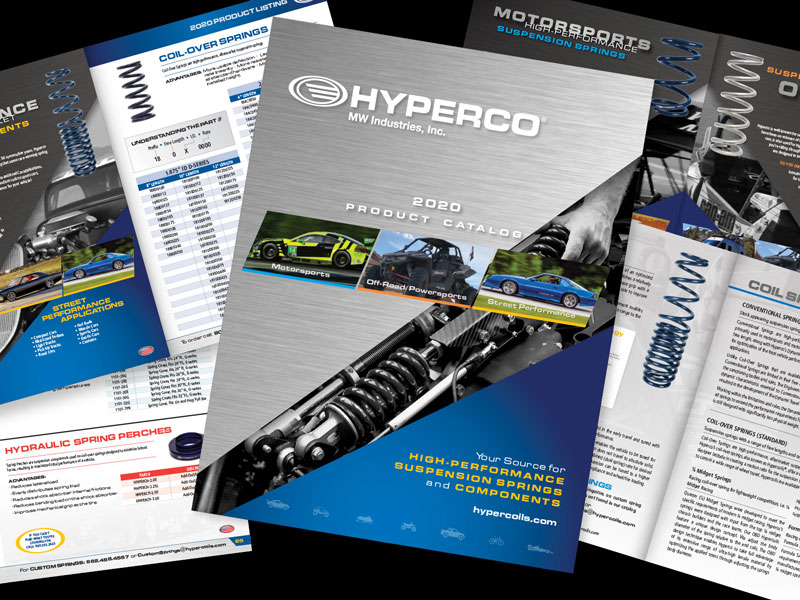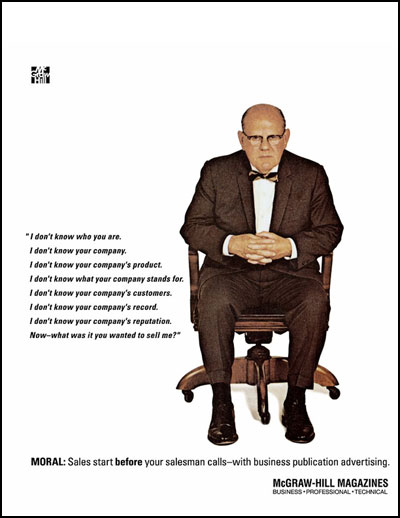
Writing for Character Count
October 17, 2019
Why B2B Marketers Shouldn’t Ditch Their Print Catalogs
December 3, 2019TRUTH
Nearly 70% of today’s industrial buyers make purchase decisions before ever reaching out to a salesperson.

Become part of the conversation from the beginning by addressing the sentiments, and marketing needs, outlined within these statements:

It’s the truth
If you haven’t done much marketing recently, most B2B buyers may know nothing about your company: your history, team members, value proposition... but if you told them, would they care?What’s important to you may not, in fact, be important to your B2B buyer.
What’s a B2B marketer to do?
- Stop talking about YOUR products and services.
- Begin talking about your CUSTOMER’S needs.
Start by talking with your current customers to develop in-depth Buyer Personas
One of the most critical building blocks of successful marketing. It isn’t enough to know who your buyers are... if you want to positively influence their purchasing decisions you need to understand the choices they make at every step in their journey.
We believe strongly in the techniques and theories developed by the Buyer Persona Institute, whose approach we use to creating powerful personas includes:
- Personal and business drivers that trigger investment in your category
- Capabilities and benefits that affect your buyer’s selection process
- Concerns that cause buyers to delay the purchase or choose a competitor
- The buyer’s decision process and which personas are key influencers
- Clarity about how many personas you need and how to define them
What do you ‘do’, exactly, with a Buyer Persona?
You put your Buyer Personas to work by developing an action plan – your BRAND STRATEGY.
By understanding your buyers’ motivations, concerns and decision process, we’ll help you create and implement the messaging that actually resonates with your buyers, to move them toward a purchase. Our BRAND STRATEGY process and deliverables will help you:
- Produce unique value propositions based on your capabilities and how well they resonate with buyers
- Ensure your marketing message and content positions your solutions as an exact match for your buyers’ needs
- Match the topics your buyers are researching with answers that demonstrate your competitive strengths
Now, more than ever, your website is a crucial element of your entire marketing strategy. An overwhelming majority (89%) of B2B buyers search the Internet during their research process – conducting as many as 12 separate searches before choosing to interact with a specific brand’s site.1
Perhaps just as surprising, between 60-70% of a buyer’s journey toward a purchase decision is already complete before a prospect even calls a potential vendor.
Your goal is to be found – and considered – within the early part of the buyer’s journey.
What are B2B buyers looking for in a helpful, informative website? What would compel a buyer to even consider visiting your site? According to a Demand Gen Report2 buyers are looking for:
- Easy access to pricing and competitive information
- Information that speaks directly to the needs of their industry
- Easy access to content (no long registration forms required)
- Content that educates and informs such as white papers, case studies and product data sheets
- Client lists and testimonials...
What if you don’t have the time/budget/resource or ideas for an entirely new website?
If your current website is lacking any of the above – don’t worry... There are methods available to help you improve your website over time – rather than ‘fixing’ it all in one fell swoop and then ignoring it for the next 3-4 years. Rather than the traditional BIG PROJECT approach to web design, consider ITERATIVE DESIGN, sometimes also referred to as growth-driven design.
Iterative Design is a methodology, when applied to website design and digital marketing, which allows you to create, test, analyze and improve your website on an ongoing basis. According to technology solutions provider, ENGINESS, there are 4 main reasons to consider ITERATIVE DESIGN:3
- It provides robust user feedback. Don’t wait until the car is driving off the assembly line before you find out it REALLY needs a steering wheel. Iterative Design allows users to see, understand and identify problems to be fixed, sooner than later.
- It can catch problems earlier. Creating, testing and improving, as you move through the design process, helps save time and money by NOT having to completely REDESIGN your website further down the line.
- It measurably improves usability. Just like the above two reasons – Iterative Design allows you to understand what IS and what ISN’T working, when you can actually do something about it.
- It’s efficient and more cost-effective than you might think. Iterative Design forces you to think about your website as a living tool, not a static digital brochure, creating a mindset designed for continuous improvement in your site – and your business’ bottom line.
Work with people who understand your manufacturing and Industrial marketplace.
Whatever approach you take to design – be sure to work with a team that has built and understands industrial websites. At Custom Direct we’ve successfully built, improved and launched websites for clients from fabricators and distributors to OEMs – we’re here to help you succeed.

Need help getting started?
Call Custom Direct at 630.529.1936 or connect with us through our form.1 Think with Google – The Changing Face of B2B Marketing
2 Demand Gen Report
3 Iterative design
Today’s B2B buyers are well connected, more demanding and much better informed due, in part, to the exponential increase in their use of Social Media. Buyers use sites like LinkedIn to research and form opinions well before engaging with a sales professional.
The growing use of ‘Social Selling’, the practice of building relationships with the right B2B buyers, staying informed on topics they care about and establishing a solid network means the ABSENCE or non-participation on LinkedIn is just as telling. According to IDC research,
“Salespeople will inadvertently deliver a negative message with their absence. Put simply, sales professionals must answer their social phones.”
And, while LinkedIn may be thought of as the social platform specifically for networking professionals, increasingly people are turning to LinkedIn to find more than just their next job opportunity. In fact, according to SharpSpring4, 91% of executives rate LinkedIn as their FIRST choice for professionally relevant content.
Do you want people to see YOUR content?
Become part of the conversation and decision making process at the beginning of their search.
Consider the following types of content which perform very well on the platform:
AUDIENCE-TARGETED TOPICS – Whether you’re using LinkedIn to network with others in your industry, or to market to your customer base, you’ll want a strategy that speaks to each specific audience.
For example: are you selling a product in the Material Handling industry? Follow news outlets and magazines like Modern Materials Handling or Material Handling 247, then share and post relevant content to capture your buyer’s attention.
MAKE IT VISUAL – A picture speaks 1,000 words – but a bad picture speaks even more. Take some time to develop methods and sources for curating and creating visual content. What does that mean? Look for interesting infographics of industry data or ‘pull’ and visualize an interesting quote or statistic from an article your sharing, for example:
“There are basically two types of people. People who accomplish things, and people who claim to have accomplished things. The first group is less crowded.”
-Mark Twain
You can bold, italicize and indent your type to make a point about the need to GET STARTED, or as Mark Twain also said, “The secret of getting ahead is getting started.”
Don’t know where to start?
Consider sharing photos from business events, conferences, awards, to give people a personal look into your company and your culture.
TRY CREATING AN INFOGRAPHIC – or find an interesting example and post it on your feed (being sure you credit the creator). Take this Infographic, for example: it illustrates the impact of using Infographics – with an Infographic!
Custom Direct can help your entire team begin using LinkedIn to grow your network and business opportunities. From providing online webinars for your team to developing sponsored content lead generation campaigns – Custom Direct has the experience to get you started Social Selling.

Need help getting started?
Call Custom Direct at 630.529.1936 or connect with us through our form.4 Best Practices for Posting on LinkedIn
Email marketing can be a powerful tool for growing your business in the industrial and manufacturing sectors, especially when selling expensive and complex products, to multiple decision-makers, over a long sales cycle.
Before allocating marketing dollars to email campaigns, you should ask yourself: Does your company have a truly defined marketing and sales cycle - including email, phone calls, physical mail, and in-person visits? Do you know WHAT you’re going to say and WHEN you’re going to say it?
Your business might benefit from marketing automation
With Integrated Email and CRM functions – which can make the process of connecting with and managing a growing number of leads much simpler and more productive.
Marketing automation tools may even ‘force’ you to analyze, standardize and improve your sales process, by identifying areas for improvement.
Salesforce defines MARKETING AUTOMATION as “technology that manages marketing processes and multifunctional campaigns, across multiple channels, automatically. With MARKETING AUTOMATION, businesses can target customers with automated messages across email, web, social, and text.”
Marketing Automation can help you have MORE meaningful, personalized interactions with more leads that are engaging and fulfilling for YOUR team AND the buyer.
How Would We Do That?
Not With...
- Static, one-way web sites
- Generic email blasts
- Treating all leads equally
- Having the same conversation with all
But With...
- Adaptive web sites based on needs
- Hyper-personalized, relevant emails
- Qualifying leads based on behavior
- Custom nurturing based on funnel state
Contact us to learn how Marketing Automation can allow you to become a part of the buyer’s journey from the beginning, with hyper-personalized conversations.
Cold calling isn’t dead, but it’s getting harder to break through.
It now takes 8+ calls before you reach a prospect.2
So why ‘cold call’ someone when you can ‘warm call’ them instead?
WARM CALLING is the practice of establishing contact with a prospect through other channels, before you make a phone call.
TRY TACTICS LIKE SOCIAL SELLING – building relationships on social media, by sharing or creating interesting content with thought leaders in your industry. You don’t need to write a blog – although it helps – simply joining LinkedIn groups and thoughtfully answering questions, or making helpful comments, will go a long way toward establishing a growing network of prospective buyers.
In fact, there are many tactics and tools available: from using an intelligent CRM system to understand who, exactly, you’re speaking with – to developing an automated series of prospecting emails offering insight and information – helping prospects who are active in their research phase.
By engaging your prospects on social media, in blogs and with your own email campaigns, you’ll be nurturing receptive people who are ready to take that potentially unexpected, but welcome, phone call.
Need help getting started?
Call Custom Direct at 630.529.1936 or connect with us through our form.
The buyer is no longer ‘me’ but ‘we’.
Gone is the grumpy ‘man in the chair’, replaced by a very busy group of men and women, six people on average, each performing multiple jobs to finalize an actual purchase, over longer and longer timeframes, including:
- Problem Identification,
- Solution Exploration,
- Requirements Building,
- Supplier Selection,
- Validation and
- Consensus Creation across all jobs and participants.
And, according to a 2019 Gartner Research report, these ‘Buying Jobs’ don’t happen in a linear, step-by-step fashion – in fact, an actual purchase decision doesn’t happen until ALL six tasks are completed at the same time.5
Managing your marketing and sales efforts – to move your B2B buyers to make the purchase – takes a coordinated strategy aimed at producing and distributing the high quality information your potential buyers are looking for.
Isn’t everyone producing ‘content’?
Yes. The digital landscape is filled with an abundance of ‘content’. Not only do buyers have access to a huge quantity of information, much of the information is of good and increasing quality.
Once again, according to the 2019 Gartner Research report, there’s almost TOO MUCH HIGH-QUALITY INFORMATION available for buyer’s to make sense of, and yet if YOUR information isn’t in the mix, you’ll never be a part of the 6-task juggling process.
But it’s not about producing reams of content. Your job is to not only INFORM, but to CONNECT with your buyers – helping them to make sense of the overwhelming information overload.
Your lead generation and sales efforts will succeed if you’re producing the information your buyers seek and you’re working to organize and align their problem-seeking activities with YOUR solutions.
Sounds difficult? Yes, but it can be accomplished with a plan!
Let Custom Direct help you get started today.

Need help getting started?
Call Custom Direct at 630.529.1936 or connect with us through our form.5 B2B Buying Journey
Everything Old is New Again...
In 1958 McGraw-Hill created what would become an iconic ad to promote the importance of advertising in their business, professional and technical publications.
The ad’s message was clear: If I don’t know anything about you or your company, before you attempt to sell me something, you won’t be very successful…
While the classic “Man In The Chair” ad spoke to a very different time – well before the internet, email, texting, and social media – the ad’s message remains the same – with a few updated considerations when Marketing for Manufacturers in 2020.





